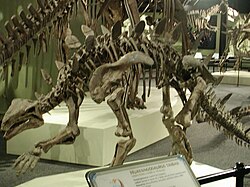Huayangosaurus
Huayangosaurus is a genus of stegosaurian dinosaur from the Middle Jurassic of China. The name comes from "Huayang", a name for Sichuan province.
| Huayangosaurus Temporal range: Middle Jurassic 165 mya
| |
|---|---|

| |
| Huayangosaurus tianfuensis in Hong Kong. | |
| Scientific classification | |
| Kingdom: | |
| Phylum: | |
| Class: | |
| Superorder: | |
| Order: | |
| Suborder: | |
| Infraorder: | |
| Family: | |
| Genus: | Huayangosaurus
|

It lived about 165 million years ago. That is some 20 million years before its famous relative, Stegosaurus appeared in North America. At only 4.5 metres long, it was also much smaller than its famous cousin. Found in the Lower Shaximiao Formation, Huayangosaurus shared the local landscape with the sauropods Shunosaurus, Datousaurus, Omeisaurus and Protognathosaurus, the ornithopod Xiaosaurus and the carnivorous Gasosaurus.
Description
Like other stegosaurians, Huayangosaurus was a quadrupedal herbivore with a small skull and a spiked tail. Huayangosaurus had the distinctive double row of plates of all stegosaurians. These plates rose vertically along its arched back. In Huayangosaurus, the plates were more spike-like than in Stegosaurus. Like Stegosaurus it had two pairs of long spikes extending horizontally near the end of its tail.
Huayangosaurus was one of the smallest known stegosaurians, at just 4.5 meters in length.
Discovery and species
Huayangosaurus remains from twelve animals were got from the Dashanpu Quarry near Zigong in Sichuan. The type species is H. taibaii.[1]
Classification
As the most basal stegosaurian, it is put in its own family Huayangosauridae. It is also morphologically distinct from later (stegosaurid) forms. Its skull was broader and had premaxillary teeth in the front of its mouth. All later stegosaurians lost these teeth.[2]
Palaeobiology
It had plates all down its back and spikes on its tail. Two large spikes were above its hips, and may have been used for deterring an attack from above (it was fairly short in height compared to later stegosaurians). Its plates were smaller than those of Stegosaurus, with much less surface area. Thus they would have been much less effective heat regulators, one of the supposed functions of plates.
Popular culture
Mounted skeletons of Huayangosaurus are on display at the Zigong Dinosaur Museum in Zigong and the Municipal Museum of Chongqing in Sichuan Province in China.
Huayangosaurus Media
- Silhouette of man standing and facing forward.svg (CC0).*References* * Skeletal diagram by Scott Hartman * Sereno,
References
- ↑ Dong Z. Tang Z. and Zhou S.W. 1982. ["Note on the new Mid-Jurassic stegosaur from Sichuan Basin, China"] (in Chinese). Vertebrata PalAsiatica 20 (1) :83-87
- ↑ Sereno P. & Dong Zhiming 1992. The skull of the basal stegosaur Huayangosaurus taibaii and a cladistic diagnosis of Stegosauria. Journal of Vertebrate Paleontology 51: 318-343
- Stegosauria, in The evolution and extinction of the dinosaurs. 2nd ed 2005. Fastovsky D.E. and Weishampel D.B. pages 107–130. Cambridge University Press. ISBN 0-521-81172-4
- Dong Zhiming (1988). Dinosaurs from China. China Ocean Press, Beijing & British Museum (Natural History). ISBN 0-565-01073-5.
- Dong Zhiming (1992). Dinosaurian faunas of China. China Ocean Press, Beijing. ISBN 3-540-52084-8.
Other websites
- Stegosauria Archived 2009-07-29 at the Wayback Machine
- Huayangosaurus Factsheet - Australian Museum


